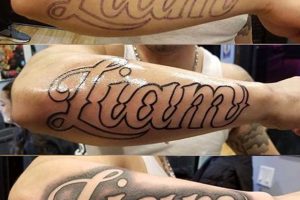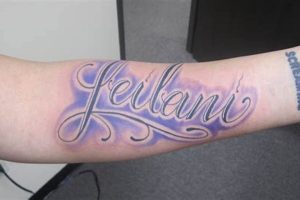Permanent body art featuring the name of a child, often a son, provides a lasting tribute to a cherished familial bond. These designs can range from simple name inscriptions to more elaborate artwork incorporating related imagery, such as birthdates, portraits, or symbolic elements like footprints or handprints.
Choosing to permanently inscribe a child’s name on one’s body represents a profound and enduring declaration of love and commitment. This practice resonates across cultures and throughout history, echoing the human desire to commemorate significant relationships. Such tattoos can serve as a constant reminder of the joys of parenthood and the enduring connection between parent and child, offering a tangible link to a deeply personal narrative.
This article will explore various design considerations, stylistic options, and placement choices for those considering commemorating their child with a name tattoo. Practical guidance regarding tattoo artist selection, aftercare procedures, and potential cultural implications will also be discussed.
Tips for Child’s Name Tattoo Designs
Careful planning ensures a meaningful and aesthetically pleasing tribute. The following suggestions offer valuable insights into the process.
Tip 1: Consider Placement Carefully: Tattoo visibility and the potential for future changes in body shape should influence placement decisions. Common locations include the forearm, chest, back, and wrist, but ultimately, the most suitable location depends on individual preferences.
Tip 2: Explore Font Options: Font selection significantly impacts the tattoo’s overall aesthetic. Script, block, and gothic fonts offer distinct stylistic choices, each conveying a different mood and message. Consulting with a skilled tattoo artist can help one navigate the numerous possibilities and select a font that complements the desired design.
Tip 3: Incorporate Symbolic Elements: Integrating elements like birthdates, zodiac signs, or meaningful imagery adds depth and personalization to the design. A skilled artist can weave these elements seamlessly into the overall composition.
Tip 4: Prioritize Quality: A tattoo is a lifelong commitment; therefore, selecting a reputable and experienced tattoo artist specializing in the desired style is essential. Researching portfolios and seeking recommendations ensures a high-quality, safe, and satisfactory result.
Tip 5: Plan for Future Additions: Consider how potential future children’s names might be incorporated into the existing design. This forward-thinking approach helps maintain a cohesive and balanced aesthetic over time.
Tip 6: Reflect on Cultural Significance: Research the cultural implications of chosen symbols or scripts, ensuring they align with one’s intended meaning and avoid unintentional misinterpretations.
Tip 7: Discuss Design with the Artist: Open communication with the chosen artist is crucial. Sharing ideas, preferences, and expectations allows for collaborative design development and ensures the final result aligns with the client’s vision.
By carefully considering these factors, individuals can create a meaningful and enduring tribute to their children.
The subsequent sections will delve further into specific design styles, aftercare procedures, and additional considerations to ensure a fulfilling experience.
1. Placement
Placement is a crucial factor in name tattoo designs honoring children. The chosen location impacts visibility, aesthetics, and the overall message conveyed. Considerations include the individual’s lifestyle, professional environment, and personal preferences. A highly visible placement, such as the forearm, broadcasts the tribute openly, while a more discreet location, like the ribcage, offers a sense of personal intimacy. The curvature of the body part also influences the design’s flow and visual impact. Names inscribed on the bicep, for example, will appear differently than those placed on a flatter surface like the back.
Practical considerations also influence placement decisions. Areas prone to friction, stretching, or sun exposure may experience faster ink fading. A name placed on the inner wrist, while visually appealing, might fade more quickly than one on the outer arm. Furthermore, individuals anticipating significant changes in body shape or weight should consider how such changes might affect the tattoo’s appearance over time. A name tattooed on the abdomen, for instance, may distort during pregnancy.
Ultimately, optimal placement balances personal significance with practical considerations. Careful planning, consultation with a skilled tattoo artist, and reflection on individual lifestyle and aesthetic preferences contribute to a thoughtfully placed and enduring tribute.
2. Font Style
Font style selection is a critical design element in junior name tattoos, significantly impacting the overall aesthetic and conveying specific emotions or messages. The chosen typeface communicates personality, complements accompanying design elements, and ensures readability over time. Understanding the nuances of various font styles allows for informed decisions that enhance the commemorative nature of the tattoo.
- Script Fonts
Script fonts, with their flowing, cursive-like appearance, evoke elegance, affection, and a sense of classicism. From delicate, flowing scripts to bolder, more dramatic calligraphy styles, script fonts offer a wide range of options suited for names. However, highly elaborate scripts can become less legible as the tattoo ages and the ink naturally spreads, a factor to consider when selecting a script font for a small-scale tattoo.
- Block Fonts
Block fonts, characterized by their clean lines and geometric shapes, offer a modern, bold, and often minimalist aesthetic. These fonts prioritize legibility and clarity, making them suitable for designs where readability is paramount. Block fonts can range from simple sans-serif styles to more ornate serif variations, offering versatility in conveying a sense of strength, stability, and directness.
- Gothic Fonts
Gothic fonts, also known as blackletter fonts, project a sense of history, tradition, and often, a touch of drama. These fonts, with their elaborate, angular letterforms, can create a striking visual impact. However, due to their intricate design, gothic fonts may not be suitable for smaller tattoos where fine details can be lost over time. Careful consideration should be given to the size and placement of the tattoo when selecting a gothic font.
- Decorative/Unique Fonts
Beyond traditional categories, numerous unique and decorative fonts exist, each with its own distinct aesthetic. These fonts can offer a personalized touch, reflecting specific interests or stylistic preferences. However, choosing a less common font requires careful consideration of its legibility and how it will age. Consulting with an experienced tattoo artist is crucial when selecting a unique font, as they can provide valuable insight into its suitability for a tattoo.
Careful font selection ensures the junior name tattoo remains a legible, aesthetically pleasing, and meaningful tribute for years to come. The chosen font should complement the overall design, reflect the individual’s personal style, and enhance the emotional impact of the tribute. Consulting with a skilled tattoo artist is crucial in navigating these stylistic choices and selecting a font that best reflects the intended message and stands the test of time.
3. Incorporated Imagery
Imagery incorporated into a junior name tattoo design significantly enhances personalization and symbolic depth. Visual elements woven into the composition create a richer narrative, reflecting the child’s personality, shared interests, or significant milestones. Careful selection of imagery adds layers of meaning beyond the name itself, transforming a simple inscription into a powerful visual story.
- Birthdate Integration
Incorporating a birthdate provides a precise and permanent record alongside the name. This can be represented numerically, using Roman numerals, or through symbolic elements representing the month of birth, such as flowers or astrological symbols. This addition adds a factual dimension to the sentimental value.
- Symbolic Representations
Symbolic elements offer a wide range of possibilities for personalized expression. Footprints or handprints capture a tangible memory of the child’s early years. Zodiac signs reflect astrological associations. Animals, flowers, or objects holding personal significance to the family can be incorporated, further enriching the narrative and symbolism.
- Portrait Integration
Including a portrait of the child, though requiring a highly skilled artist, offers a deeply personal and visually striking tribute. This approach allows for a realistic or stylized representation of the child’s likeness, creating a lasting visual connection. However, portrait tattoos require careful consideration of aging and potential changes in the child’s appearance over time.
- Thematic Elements
Incorporating thematic elements related to shared interests or hobbies further personalizes the tattoo. A musical note for a musically inclined child, a sports emblem for a young athlete, or a favorite cartoon character can represent shared passions and create a visual reminder of cherished moments. These elements offer a unique and personal touch, enhancing the overall design’s meaning.
The thoughtful integration of imagery elevates junior name tattoos beyond simple inscriptions, transforming them into intricate and deeply personal works of art. These visual elements add layers of narrative, symbolism, and emotional resonance, strengthening the bond represented by the tattoo and creating a lasting tribute to the parent-child connection.
4. Cultural Sensitivity
Cultural sensitivity plays a vital role in the design process of junior name tattoos. Names, symbols, and imagery carry cultural weight; therefore, careful research and understanding are crucial to avoid misappropriation or misrepresentation. Script choices, in particular, demand attention to cultural context. Utilizing a script from a culture not associated with the family’s heritage can be viewed as disrespectful or trivializing. Similarly, incorporating symbols with religious or spiritual significance without understanding their full meaning can lead to unintended offense. For instance, using characters from Asian languages solely for their aesthetic appeal without understanding their actual meaning constitutes cultural appropriation and disrespects the associated culture. This applies equally to symbols and imagery from indigenous cultures worldwide. A design referencing indigenous art without genuine connection to the culture reduces significant cultural heritage to mere decoration.
Beyond script and symbols, even color choices can carry cultural meanings. Certain colors symbolize mourning or celebration in different cultures. Including such colors without awareness of their cultural context could convey an unintended or inappropriate message. Therefore, comprehensive research is paramount. Consulting with cultural experts or individuals belonging to the culture from which the design elements are drawn provides valuable insight and helps avoid unintentional cultural insensitivity. This demonstrates respect for the cultural heritage associated with the chosen elements and ensures the tattoo holds genuine meaning without causing offense.
Demonstrating cultural sensitivity ensures a respectful and meaningful tribute. A well-researched design avoids unintended negative connotations and reflects a genuine appreciation for the chosen elements’ cultural heritage. This conscientious approach enriches the tattoo’s significance, enhancing its value as a thoughtful and culturally appropriate commemoration. By prioritizing cultural understanding and respecting the rich history behind chosen symbols and scripts, individuals create a tribute that honors both their child and the cultures represented in the design.
5. Artist Selection
Selecting a skilled tattoo artist is paramount when considering a junior name tattoo. This decision significantly impacts the final result, influencing the design’s aesthetic quality, longevity, and overall success. A thoughtful approach to artist selection ensures a meaningful and well-executed tribute.
- Portfolio Examination
A thorough review of an artist’s portfolio provides crucial insight into their style, technical proficiency, and specialization. Portfolios showcase completed works, demonstrating the artist’s skill in various styles, from intricate scripts to detailed portraits. Examining healed tattoos within the portfolio offers a realistic view of the long-term quality and how the ink ages over time. Focusing on examples of name tattoos or similar fine-line work within the portfolio helps assess the artist’s suitability for the specific project.
- Specialization and Experience
Different artists specialize in various tattooing styles. Some excel in fine-line work, crucial for intricate scripts and delicate details, while others specialize in realism, essential for portrait or complex imagery incorporation. Prioritizing artists with demonstrated experience in the desired style ensures the final result aligns with expectations. Experience within the specific niche of name tattoos demonstrates an artist’s understanding of design considerations unique to this form of commemorative body art.
- Hygiene and Safety Practices
Adherence to strict hygiene and safety protocols is non-negotiable. A reputable artist prioritizes client safety, using sterilized equipment, disposable needles, and maintaining a clean workspace. Enquiring about sterilization procedures and observing the studio environment during consultations confirms the artist’s commitment to safe practices, minimizing health risks associated with the tattooing process.
- Client Communication and Collaboration
Effective communication and a collaborative approach between the client and artist are essential for a successful outcome. A skilled artist actively listens to the client’s vision, offering guidance and expertise to refine the design. Open communication ensures the final design reflects the client’s desires while incorporating the artist’s technical knowledge and artistic sensibilities. A collaborative relationship fosters trust and ensures a shared understanding of the project’s goals.
Careful artist selection ensures the junior name tattoo becomes a cherished and well-executed piece of art. By prioritizing experience, specialization, hygiene, and open communication, individuals can confidently entrust their vision to a skilled professional, resulting in a meaningful and enduring tribute to their child. This investment in finding the right artist safeguards both the aesthetic quality of the tattoo and the health and safety of the individual receiving it.
6. Size and Scale
Size and scale are critical design elements in junior name tattoos, impacting legibility, aesthetics, and the overall balance of the composition. Careful consideration of these factors ensures the tattoo remains visually appealing and meaningful over time. Proportionality relative to the chosen body part and the inclusion of other design elements are key considerations in determining appropriate size and scale.
- Body Part Considerations
The size and scale of the tattoo should complement the chosen body part. A large-scale design may overwhelm a smaller area like the wrist or ankle, while a small, intricate design might get lost on a larger area like the back. The contours of the body also influence how the design lays and its visual impact. Careful planning ensures the tattoo harmonizes with the body’s natural curves.
- Legibility Over Time
Intricate details and small text can become less legible as the tattoo ages and the ink naturally spreads. Choosing a size and scale that allows for clear readability over time ensures the name remains easily discernible. This is particularly important for script fonts and designs incorporating small symbols or fine lines. A larger scale often ensures continued legibility.
- Balance and Composition
Size and scale directly impact the overall balance and composition of the tattoo, especially when incorporating additional design elements. The name’s size should be proportionate to accompanying imagery, dates, or other symbols. A balanced design ensures no single element overwhelms the others, creating a harmonious visual flow and preventing a cluttered appearance. Proper scaling creates a cohesive and aesthetically pleasing design.
- Practical Implications
Practical considerations, such as clothing restrictions or professional requirements, may influence size and scale decisions. Individuals in professions with strict dress codes might opt for smaller, more easily concealed designs. Similarly, the desired level of visibility influences size choices. A large, prominently placed tattoo conveys a different message than a small, discreetly placed one. These practical considerations ensure the tattoo aligns with the individual’s lifestyle and professional needs.
Harmonizing size and scale with the chosen body part, desired level of detail, and long-term legibility considerations ensures a junior name tattoo remains a visually appealing and meaningful tribute. By carefully considering these factors, individuals create a design that complements their body, effectively conveys the intended message, and stands the test of time. This attention to detail ensures a lasting tribute that honors both the child and the wearer’s aesthetic preferences.
7. Long-Term Implications
Permanently marking the body with a child’s name carries significant long-term implications demanding careful consideration. These implications extend beyond the immediate aesthetic result, encompassing potential shifts in personal relationships, evolving societal perceptions, and the tattoo’s physical longevity. Prudent foresight ensures the decision aligns with one’s long-term values and life trajectory.
- Evolving Relationships
Relationships evolve over time, and while the bond with a child is typically enduring, unforeseen circumstances can alter family dynamics. Changes in familial relationships, while rare, can imbue a name tattoo with unintended emotional weight. Considering the potential for evolving family dynamics adds a layer of complexity to the decision-making process.
- Societal Perceptions
Societal perceptions of tattoos shift across generations and cultural contexts. While tattoos are increasingly accepted in many contemporary societies, certain professional environments may still hold reservations. Considering potential career paths and evolving societal norms ensures the tattoo remains a source of pride rather than a potential impediment. Future social contexts should be considered in placement and design choices.
- Physical Changes and Aging
The human body undergoes natural changes over time, including weight fluctuations and skin aging. These changes can affect the tattoo’s appearance, potentially distorting the design or impacting ink clarity. Placement on areas prone to significant change, like the abdomen or upper arms, requires careful consideration of potential distortion. Selecting a skilled artist experienced in creating designs that age well mitigates this risk.
- Tattoo Removal or Alteration
While laser tattoo removal offers a solution for unwanted tattoos, it is a costly, time-consuming, and potentially painful process. Cover-up tattoos provide an alternative, but design options are limited by the existing ink. Recognizing tattoo removal or alteration as a potential future need emphasizes the importance of careful initial design choices. Viewing the tattoo as a permanent commitment underscores the significance of the decision.
Careful consideration of these long-term implications ensures a junior name tattoo remains a cherished symbol of familial love and commitment. Thoughtful planning, informed decision-making, and realistic expectations surrounding the tattoo’s permanence contribute to a positive and enduring outcome. Acknowledging the potential for personal, societal, and physical changes allows individuals to approach this permanent decision with informed awareness, minimizing potential future regrets and maximizing the tattoo’s long-term significance.
Frequently Asked Questions
Addressing common queries regarding name tattoos honoring children provides clarity and facilitates informed decision-making. The following questions and answers offer valuable insights into the process.
Question 1: What are the most suitable body areas for a child’s name tattoo?
Placement depends on individual preferences regarding visibility and pain tolerance. Common locations include the inner forearm, chest, upper back, and outer thigh. Areas subject to frequent stretching or sun exposure should be considered carefully.
Question 2: How can one ensure the tattoo remains legible over time?
Choosing a simple, bold font and an appropriate scale are crucial for long-term legibility. Intricate scripts or small-scale designs might blur as the tattoo ages. Consulting an experienced artist specializing in fine-line work is recommended.
Question 3: What are the potential cultural implications of incorporating symbols or scripts?
Thorough research is essential to avoid unintentional cultural appropriation or misrepresentation. Understanding the cultural context of chosen symbols and scripts ensures a respectful and meaningful design.
Question 4: How does one select a reputable and skilled tattoo artist?
Reviewing artist portfolios, seeking recommendations, and verifying adherence to hygiene standards are crucial steps in selecting a qualified artist. Open communication about design preferences and expectations is also essential.
Question 5: What is the typical healing time for a name tattoo, and what aftercare practices are recommended?
Healing typically takes several weeks. Following the artist’s aftercare instructions, including keeping the tattoo clean and moisturized, and avoiding sun exposure, promotes proper healing and prevents complications. Specific healing times vary based on individual factors and tattoo size.
Question 6: What factors should one consider regarding future additions to the tattoo, such as additional children’s names?
Planning for potential future additions during the initial design phase ensures a cohesive final result. Discussing potential future elements with the artist allows for a design that can be expanded upon harmoniously without appearing cluttered.
Careful consideration of these frequently asked questions provides a solid foundation for making informed decisions about junior name tattoos. Thorough planning, open communication with a skilled artist, and realistic expectations ensure a meaningful and enduring tribute.
This concludes the FAQ section. The following section offers a concluding summary of key considerations and final recommendations.
Conclusion
Commemorating a child’s name through permanent body art represents a profound commitment. Careful consideration of design elements, placement, cultural sensitivity, artist selection, and long-term implications ensures a meaningful and enduring tribute. Font choices, incorporated imagery, and size considerations contribute to the tattoo’s overall aesthetic and legibility over time. Prioritizing hygiene and safety during the tattooing process, followed by diligent aftercare, ensures optimal healing and preserves the design’s integrity. Acknowledging potential changes in personal circumstances, societal perceptions, and the body’s natural aging process allows for informed decisions that minimize future regrets.
A thoughtfully designed and expertly executed name tattoo serves as a lasting testament to the enduring parent-child bond. This permanent expression of love and commitment requires careful planning and informed decision-making to ensure a result that resonates with personal values and stands the test of time. Ultimately, a well-executed tattoo transcends mere aesthetics, becoming a powerful symbol of familial connection and a lifelong source of personal meaning.







